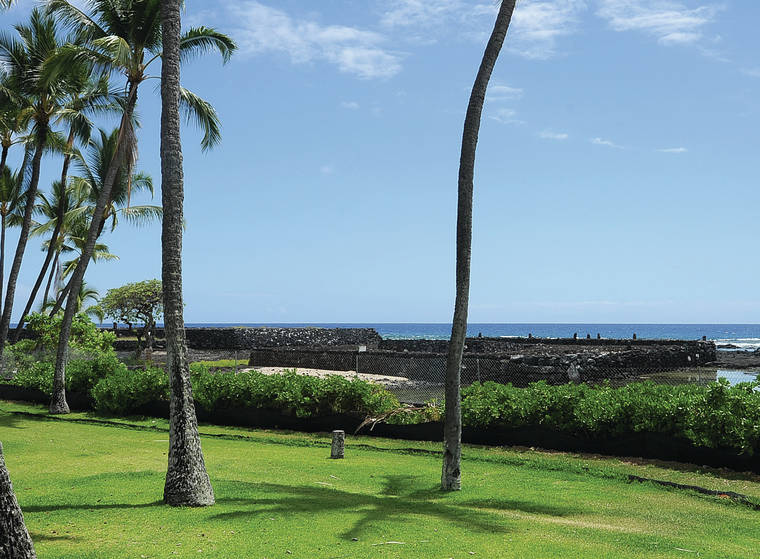Kahaluu Ma Kai slated for completion in 2020
KAILUA-KONA — Every day, a historic plot of oceanfront aina is regaining more of its natural ambiance.
Kamehameha Schools’ deconstruction of the old Keauhou Beach Hotel is on track for completion by summer 2020. Yet even while crews are busy making way for the organizational vision of a nature-based educational and cultural center dubbed Kahaluu Ma Kai, learning at the site has already begun.
Contractors have removed more than 15,000 tons of construction material, nearly all of which has been recycled. A new phase of the project began in January and includes grading and landscaping, building walking paths and viewing platforms, updating utilities, security and the parking lot, while also planning for shoreline access.
The only planned structure is a comfort station with restrooms and showers for visitors to the site, which will consist primarily of school groups. Construction of an open-air hale at some future point remains a possibility.
“I think for us right now, the most important thing is to reconnect students to the aina. We think the best way to do that is outdoors, not building four more walls,” said Crystal Kua, communications specialist for Kamehameha Schools. “It’s scaled back, I think, a lot from what we originally told the community about. For us, it’s just getting learners back on site and having them be comfortable.”
One Hawaii Island local who grew up playing tennis and fishing with his father on the property, CJ Kow, has been learning on the site over the last two years through an internship with Kamehameha Schools.
Kow, 24, who recently earned a master’s degree from the University of Hawaii at Hilo in tropical conservation biology and environmental science, has been conducting water quality testing along the shoreline focused on temperature, salinity and dissolved oxygen levels.
He grew up hearing stories about the area, his kupuna referencing an estuary that created an abundance of several types of fish prior to extensive shoreline development.
During his work measuring salinity and fresh water outputs, which are numerous along those shores, Kow confirmed through science the truths of what he’d always been told — establishing a connection between scientific method and local lore.
It’s exactly the kind of educational experience Kamehameha Schools envisions for learner groups who will visit the site in years to come.
“Being able to actually measure that with modern, scientific instruments and connect it to the historical, cultural knowledge is a mind blowing thing to do,” Kow said. “The best way to … bridge the gap between the public and the scientific community … is by bringing people onto these kinds of sites, outdoor adventures and whatnot, and to actually educate them at the same time.”
The purpose of Kow’s work is to develop a pre-demolition water quality baseline for the shoreline fronting Kahaluu Ma Kai so as to compare it to water quality post-demolition and understand how even the presence of the hotel might have impacted the ecosystem and nearby cultural sites.
Estuaries, where fresh water empties into the ocean, create brackish swaths of water with a high dissolved oxygen content that Kow said are vital to ecosystem and marine life health. Having developed the shoreline employing concrete, the hotel may have blocked some freshwater outflows. Deconstruction is likely to reverse that, if it occurred.
Even the shade produced by the hotel’s height and breadth is enough to create a potential impact.
“Just having the hotel there and having shade, that can actually affect photosynthesis rates of photosynthetic organisms to some level,” Kow said. “That would in turn affect dissolved oxygen rates, which in turn would affect the ecosystem. So it’s like a whole chain reaction there.”
Access plans for Kahaluu Ma Kai aren’t yet set in stone, unlike the heiau fronting the property that Kamehameha Schools will protect and manage. The organization is mandated to provide shoreline access. As for the site’s educational programming, Kua couldn’t say whether it would be appointment only, open to the general public or some combination of the two.
But despite all the changes on the property in the last two years, and the changes and decisions yet to come, the goal of Kahaluu Ma Kai remains unambiguous.
“(Kow) is a modern-day example of coming back to his roots here, and the experience he had here helping him continue learning on a site that we want to (preserve) as the focus of education,” Kua said. “Especially in terms of culture and bridging our past with our future, and Hawaiian culture with Western science.”





